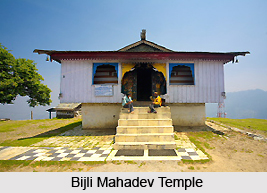 Bijli Mahadev Temple, dedicated to Lord Shiva, is located in Kullu, Himachal Pradesh. It is at a distance of 11 kilometers from the Kullu valley. Situated on a Himalayan hilltop, the temple site offers a panoramic view of the Kullu and Parvati valleys below. The temple is renowned for its 60 feet high flagpole that sparkles like a silver needle while basking in the glory of sunlight. The flagpole is visible even from Kullu. This high structure draws divine blessings in the form of lightening and it is said that with every flash of lightening, the Shiva linga is shattered to pieces. Each time this phenomenon occurs, the Shiva linga is replaced by the priest by covering it with sattoo (a paste of roasted gram and wheat powder) and butter. It is due to this legend that the temple has been name Bijli (lightening) Mahadev (another name for Lord Shiva).
Bijli Mahadev Temple, dedicated to Lord Shiva, is located in Kullu, Himachal Pradesh. It is at a distance of 11 kilometers from the Kullu valley. Situated on a Himalayan hilltop, the temple site offers a panoramic view of the Kullu and Parvati valleys below. The temple is renowned for its 60 feet high flagpole that sparkles like a silver needle while basking in the glory of sunlight. The flagpole is visible even from Kullu. This high structure draws divine blessings in the form of lightening and it is said that with every flash of lightening, the Shiva linga is shattered to pieces. Each time this phenomenon occurs, the Shiva linga is replaced by the priest by covering it with sattoo (a paste of roasted gram and wheat powder) and butter. It is due to this legend that the temple has been name Bijli (lightening) Mahadev (another name for Lord Shiva).
Another legend associated with this shrine at Kullu narrates that Vashishth muni prayed at the temple site to Lord Shiva and requested him to absorb the energy of the lightening in order to save the world. His prayers were answered by the lord. This miracle took place at the confluence of the Beas River and Parvati River. To mark this incident a temple was constructed here and named Bijli Mahadev, connoting the `Temple of Lightening.`
Moreover, according to popular beliefs while the linga breaks down a lot of energy is emitted from it. This energy is absorbed by Lord Shiva, thus, preventing the universe from destruction. Built by following the Pahari idiom of temple architecture, there is an impressively carved image of the Nandi bull at the entrance of Bijli Mahadev temple. The temple doors are also beautifully carved with sculptures that are worth beholding. As per history the Pahari temple architecture in Himachal Pradesh was prevalent from 8th to 13th centuries. This shrine, too, was probably built during this time.
During the new moon day of Shravana month, devotees offer prayer to their forefathers at Bijli Mahadev temple. A fair is also organised every year at this time which is quite popular with the pilgrims. Both devotees and tourists from different corners of India flock to the Bijli Mahadev temple during this time.





















